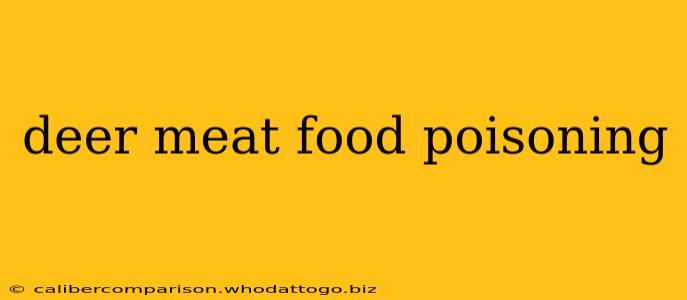Deer meat, or venison, is a lean and flavorful protein source enjoyed by many. However, like any wild game, it carries a risk of foodborne illness if not handled and prepared correctly. This comprehensive guide explores the potential dangers of food poisoning from venison, preventative measures, and what to do if you suspect contamination.
Types of Food Poisoning from Deer Meat
Several bacteria and parasites can contaminate venison, leading to food poisoning. The most common culprits include:
1. E. coli:
- This bacterium is prevalent in the environment and can easily contaminate meat during the field dressing process or subsequent handling. E. coli infection can cause diarrhea, stomach cramps, and vomiting. While most strains are relatively harmless, some can cause severe illness.
2. Salmonella:
- Similar to E. coli, Salmonella is a common bacterial contaminant that can be present in the animal's intestines and spread during processing. Symptoms include fever, diarrhea, vomiting, and abdominal cramps.
3. Campylobacter:
- Another common bacterial source of food poisoning, Campylobacter is often found in the intestines of wild animals. Symptoms typically manifest as diarrhea, stomach cramps, and fever, sometimes accompanied by vomiting.
4. Parasites:
- Various parasites, such as Toxoplasma gondii (responsible for toxoplasmosis) and Trichinella spiralis (causing trichinosis), can be present in deer muscle tissue. These parasites can cause serious health problems if ingested. Trichinosis, in particular, requires thorough cooking to eliminate. Toxoplasmosis can be particularly dangerous for pregnant women and individuals with compromised immune systems.
Preventing Food Poisoning from Venison
Proper handling and preparation are crucial in minimizing the risk of food poisoning from venison:
1. Field Dressing:
- Hygiene is paramount: Wear clean gloves and thoroughly wash your hands before and after field dressing. Minimize contamination by using clean tools and avoiding contact with the animal's feces and internal organs.
2. Meat Storage:
- Rapid chilling: Cool the venison quickly after field dressing. This slows the growth of bacteria. Aim for an internal temperature of 40°F (4°C) or lower within 2 hours.
3. Processing and Cooking:
- Thorough cooking: This is the most effective way to kill harmful bacteria and parasites. Ensure the meat reaches an internal temperature of 160°F (71°C) throughout. Use a food thermometer to verify.
- Proper handling: Maintain good hygiene while processing and preparing the meat. Wash your hands, utensils, and cutting boards thoroughly. Avoid cross-contamination by keeping raw venison separate from other foods.
4. Safe Storage:
- Store venison properly in the refrigerator or freezer. Refrigerated venison should be consumed within 3-5 days; frozen venison can be stored for several months.
Symptoms of Venison-Related Food Poisoning
Symptoms of food poisoning from venison can vary depending on the causative agent and the individual's susceptibility. Common symptoms include:
- Diarrhea
- Nausea
- Vomiting
- Stomach cramps
- Fever
- Muscle aches (especially with trichinosis)
If you experience these symptoms after consuming venison, seek medical attention immediately, especially if symptoms are severe or prolonged. Be sure to inform your doctor about your venison consumption.
Conclusion: Enjoying Venison Safely
Venison is a delicious and nutritious food, but safe handling and preparation are essential to prevent food poisoning. By following these guidelines, you can significantly reduce your risk and enjoy this lean protein source without worry. Remember, when in doubt, consult a medical professional. This information is for educational purposes and should not be considered medical advice. Always consult with a healthcare provider for any health concerns.

